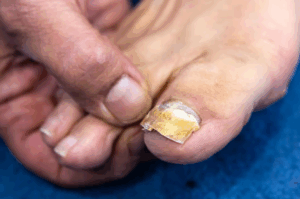Hydrogen Peroxide for Toenail Fungus
Hydrogen Peroxide for Toenail Fungus: A Natural Remedy Worth Exploring

Toenail fungus, also known as onychomycosis, is a common and often frustrating condition that affects many individuals. It can cause nails to become discolored, thickened, and brittle, leading to discomfort and self-consciousness.
While there are various pharmaceutical treatments available, some people prefer natural remedies to avoid potential side effects. One such remedy is hydrogen peroxide, a versatile household product with antifungal properties.
In this article, we’ll explore how hydrogen peroxide can help treat toenail fungus, its benefits, how to use it, and precautions to take when using this remedy.
What is Hydrogen Peroxide?
Hydrogen peroxide is a chemical compound made up of two hydrogen atoms and two oxygen atoms (H₂O₂).
It is commonly used as a disinfectant and antiseptic for cleaning wounds, surfaces, and various medical purposes. It is available in various concentrations, with the most common being a 3% solution, which is safe for topical use.
Hydrogen peroxide works as an oxidizing agent, which means it can break down into water and oxygen, releasing oxygen molecules that can kill bacteria, fungi, and viruses.
This makes it a potent antiseptic, and when used in the right concentrations, it can help address fungal infections like toenail fungus.
What Causes Toenail Fungus?
Toenail fungus occurs when fungi, such as dermatophytes, molds, or yeasts, infect the toenail and nail bed.
The infection is typically characterized by discoloration, thickening, and crumbling of the toenail, and it thrives in warm, damp environments. Factors that contribute to the development of toenail fungus include:
- Moist environments: Wearing tight shoes, sweating, or walking barefoot in places like public pools and showers can create an environment where fungi thrive.
- Poor hygiene: Not properly cleaning and drying your feet can increase the risk of fungal infections.
- Weakened immune system: A compromised immune system makes it more difficult for the body to fight off infections, increasing susceptibility to fungal infections.
- Pre-existing conditions: Certain conditions like diabetes, poor circulation, and obesity can also increase the likelihood of developing toenail fungus.
Toenail fungus is often a persistent condition that can be difficult to treat. While antifungal medications are commonly used, many individuals seek alternative remedies, such as hydrogen peroxide, to help manage the infection.
How Hydrogen Peroxide Helps with Toenail Fungus?
Hydrogen peroxide’s ability to kill bacteria, fungi, and viruses is one of the main reasons it can be effective for treating toenail fungus. Below are the key ways in which hydrogen peroxide may help address toenail fungus:
Antifungal Properties:
- Hydrogen peroxide acts as an oxidizing agent, releasing oxygen molecules that can destroy the cell walls of fungi. By breaking down the fungi’s structure, hydrogen peroxide can inhibit its growth and spread. This can help reduce the severity of the infection and prevent it from spreading to other nails or areas of the skin.
Cleansing the Nail:
- Hydrogen peroxide is a natural disinfectant, which means it can cleanse the infected area of dirt, debris, and bacteria. By cleaning the toenail and surrounding skin, hydrogen peroxide helps create an environment that is less conducive to fungal growth. This can also reduce the risk of secondary bacterial infections that can complicate the fungal infection.
Promoting Healing:
- One of the reasons hydrogen peroxide is commonly used for wound care is its ability to promote healing. When applied to the affected toenail, hydrogen peroxide can help clean the wound and stimulate tissue regeneration. This may contribute to faster healing of the infected area and support the body’s ability to fight off the fungus.
Reducing Odor:
- Toenail fungus can often produce a foul smell due to the buildup of bacteria and fungi. Hydrogen peroxide can help neutralize these odors, providing a more pleasant experience during the treatment process.
Preventing Recurrence:
- Regular use of hydrogen peroxide to treat toenail fungus may also help prevent the recurrence of the infection. By regularly disinfecting the toenail and surrounding skin, hydrogen peroxide can help eliminate any remaining fungi or bacteria, reducing the likelihood of future infections.

Benefits of Using Hydrogen Peroxide for Toenail Fungus
Affordable and Accessible:
- Hydrogen peroxide is inexpensive and readily available at most pharmacies and grocery stores. It’s a cost-effective option for people who want to treat toenail fungus without breaking the bank on prescription medications.
Natural Remedy:
- Many individuals prefer natural treatments over pharmaceutical ones due to concerns about side effects. Hydrogen peroxide is a relatively safe, natural product that can be used topically with minimal risk of adverse reactions when used correctly.
Non-Invasive Treatment:
- Hydrogen peroxide can be applied directly to the affected area without the need for invasive procedures. This makes it a simple and convenient treatment option for those who prefer at-home remedies.
Minimal Side Effects:
- When used in appropriate concentrations (typically a 3% solution), hydrogen peroxide generally has minimal side effects. Unlike oral antifungal medications, which can come with a range of potential side effects, hydrogen peroxide is unlikely to cause systemic issues when used topically.
Ease of Use:
- Using hydrogen peroxide for toenail fungus is straightforward and requires no special equipment. All you need is the solution and a few minutes of your time. This makes it an easy and accessible treatment option for people who want a quick and simple solution.
How to Use Hydrogen Peroxide for Toenail Fungus?
To effectively use hydrogen peroxide for toenail fungus, it’s important to follow a few simple steps:
1. Prepare the Area
Before applying hydrogen peroxide, ensure that your feet are clean and dry. Wash your feet with warm water and soap, then dry them thoroughly, especially between your toes, as moisture can promote further fungal growth.
2. Apply Hydrogen Peroxide
- Soaking Method: You can soak your feet in a solution of hydrogen peroxide and water. Mix a 50/50 solution of hydrogen peroxide (3%) and warm water in a basin. Soak your feet for about 15–20 minutes. This will help disinfect the toenail, soften the nail, and kill the fungus.
- Direct Application: Alternatively, you can apply hydrogen peroxide directly to the affected toenail using a cotton ball or swab. Dab the solution on the nail and allow it to sit for a few minutes before wiping off any excess.
3. Dry Your Feet
After applying hydrogen peroxide, dry your feet thoroughly. Fungi thrive in moist environments, so it’s essential to ensure your feet are completely dry to prevent reinfection.
4. Repeat the Process
For best results, repeat the hydrogen peroxide treatment once or twice daily. Consistency is key in treating toenail fungus, as it can take time to see noticeable improvement. Continue the treatment for several weeks, even after the visible symptoms have improved, to ensure the fungus is completely eradicated.
5. Combine with Other Treatments
Hydrogen peroxide can be used in combination with other antifungal treatments for enhanced results. For example, you may choose to apply an over-the-counter antifungal cream or oil after using hydrogen peroxide. Natural oils like tea tree oil or coconut oil have additional antifungal properties that can help complement the effects of hydrogen peroxide.
Precautions and Considerations
While hydrogen peroxide is a relatively safe treatment option for toenail fungus, there are a few precautions to consider:
- Concentration: Always use a 3% hydrogen peroxide solution for topical use. Higher concentrations can be too harsh on the skin and may cause irritation. If you’re unsure, it’s best to dilute the hydrogen peroxide with water.
- Skin Irritation: Some individuals may experience skin irritation or dryness when using hydrogen peroxide, especially if used too frequently. If irritation occurs, reduce the frequency of use or discontinue the treatment and consult a healthcare provider.
- Avoid Open Wounds: Do not use hydrogen peroxide on open cuts, wounds, or broken skin. While hydrogen peroxide is an effective disinfectant, it can irritate open wounds and delay the healing process.
- Consult a Healthcare Provider: If the toenail fungus does not improve after several weeks of treatment, or if the infection worsens, it may be necessary to consult a healthcare provider. Severe or persistent toenail fungus may require prescription antifungal medications or other more advanced treatments.
- Avoid Overuse: Overuse of hydrogen peroxide can lead to excessive dryness or peeling of the skin. Always ensure you moisturize your feet after treatment to keep the skin healthy and prevent cracking.
Conclusion
Hydrogen peroxide is a powerful, accessible, and cost-effective remedy for treating toenail fungus. Its antifungal properties, combined with its ability to cleanse and promote healing, make it an excellent option for individuals seeking a natural solution to toenail infections.
Whether used as a soak or applied directly to the affected area, hydrogen peroxide can help reduce the appearance and severity of toenail fungus over time.
While hydrogen peroxide can be effective for treating mild to moderate toenail fungus, more severe infections may require additional treatments.
Always consult with a healthcare provider if you have concerns or if the infection persists. With consistent use and proper care, hydrogen peroxide can be a valuable part of your toenail fungus treatment plan, helping you restore your nails to their healthy, natural state.

.